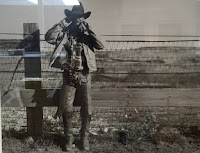Today I visited the TATE Modern, Bankside Gallery and the Michael Hoppen Gallery.
In the Michael Hoppen there was an exhibition of photographs by Ken Griffiths. Each was
of a scene, character or object related to the photographer’s home state of
Texas. The collection, named 'Texas Panhandle' felt personal. In writing Griffiths expressed words of great
feeling towards not just the people of his community but the state itself. I
felt this was relevant in terms of the ‘emotional attachment’ umbrella from my
original mind map. Griffiths spoke of the importance of the ‘cowboy hat’ within the
community; the hat for them is an extension of their personality/ something
attached to them entirely. I was taken by one close up photograph of an elder
gentleman’s hand. The wrinkles upon it had so much history; his age and wisdom
celebrated in those creases and dapples.
 |
| Ken Griffiths at the Michael Hoppen Gallery- Texan character |
 |
| Sketch Author's own |
At Bankside Gallery I found one piece worth mentioning. The
linear simplicity of Nana Shiomi’s ‘Basic Room’ was structural and clean and
relevant to my brief.
 |
| Nana Shiomi's 'Basic Room' |
Inside TATE modern was a wealth of inspiration. I loved
Rachel Whiteread’s photographic depiction of the destruction of concrete
housing blocks in east London. Her collection followed the demolition of the
structured building. Construction, deconstruction and or demolition become at
times the inevitable lifecycle of some structures. I noted that something once
strong and concrete can soon be smoke and clouds; that structures can become
dust.
 |
| Rachel Whiteread at The Tate Modern |
Marwan Rechmaomi’s sculpture of the incomplete concrete
office block that dominates the Beirut skyline (a vantage point for snipers
during the Lebanese civil war) was an emotional response to the building that
serves as an unofficial memorial to the conflict in Lebanon. The structure is
bleak, grey and unwelcoming. The harsh lines reflect the harshness of the
Lebanese wartime and those that suffered and still suffer its consequences.
 |
| Marwan Rechmaomi at The Tate Modern |
 |
| Sketch Author's own Marwan Rechmaomi |
Victor Pasmore believed art derived from nature and
‘specifically from its underlying processes and structures’. His 1963 Perspex
and painted wood sculpture aims to explore growth and abstract harmony and is
his response to natural structure. His unconventional response demonstrated to
me the breadth of opportunity for outcomes derived from the theme of ‘natural
structure’; I still intend to do further research into the hidden structures of
nature. I also loved the shadows the
sculpture cast on the floor- the tones created by light inspire me regarding
the ‘monotone’ criteria of my brief.
 |
| Photograph Author's own Shadows |
A painting by Malangtana Ngwenya depicted the communal
suffering of the Mozambique war of independence. I was moved by Ngwenya’s
choice to paint community over an individual. I considered this an example of
how strong attachment within a community can be. The work demonstrated the
importance of social relationships within times of suffering.
 |
| Malangtana Ngwenya at The Tate Modern |
Photography by Bernd and Hilla Becher was an exquisite
exploration of structure and the variations of form within the same type of
structure. Their shots of industrial structures across the world have a sense
of time, place and history. Each had been taken during overcast weather ‘to
avoid shadows’, leaving a clean and sharp aesthetic. I loved how one type of structure,
for example a water tower, was shown in so many different shapes and variation.
This has inspired me to photograph one specific type of thing in many different
places.
 |
| Photography by Bernd and Hilla Becher |
 |
| Richard Deacon at The Tate Modern (bronze and nuts and bolts) |
 |
Richard Deacon at
The Tate Modern
(flattened bottle tops and copper staples) |
 |
Photograph Author's own-
Sheela Gowda at
The Tate Modern |
 |
| Sketch Author's own |
Finally Boris Mikhailov’s series of photographs taken in Kharkov, Ukraine, for me, explored human and communal relationships/ attachment in a playful and insightful manner. His lens captures familiar moments, joy and character. This kind of approach to attachment within community could be relevant for my brief.
 |
| Boris Mikhailov at The Tate Modern |
Today I captured more inspiring buildings. I was particularly drawn towards visible construction. I liked the underneath of bridges, the beam-like structures inside the Tate as well as sharp lined glass architecture on Blackfriars rail station. The lines and silhouettes created by these buildings and structures inspire me for potential print design, sleeve shapes and general silhouette as well as colour choice.
 |
| Photograph Author's own- Blackfriars bridge |
No comments:
Post a Comment